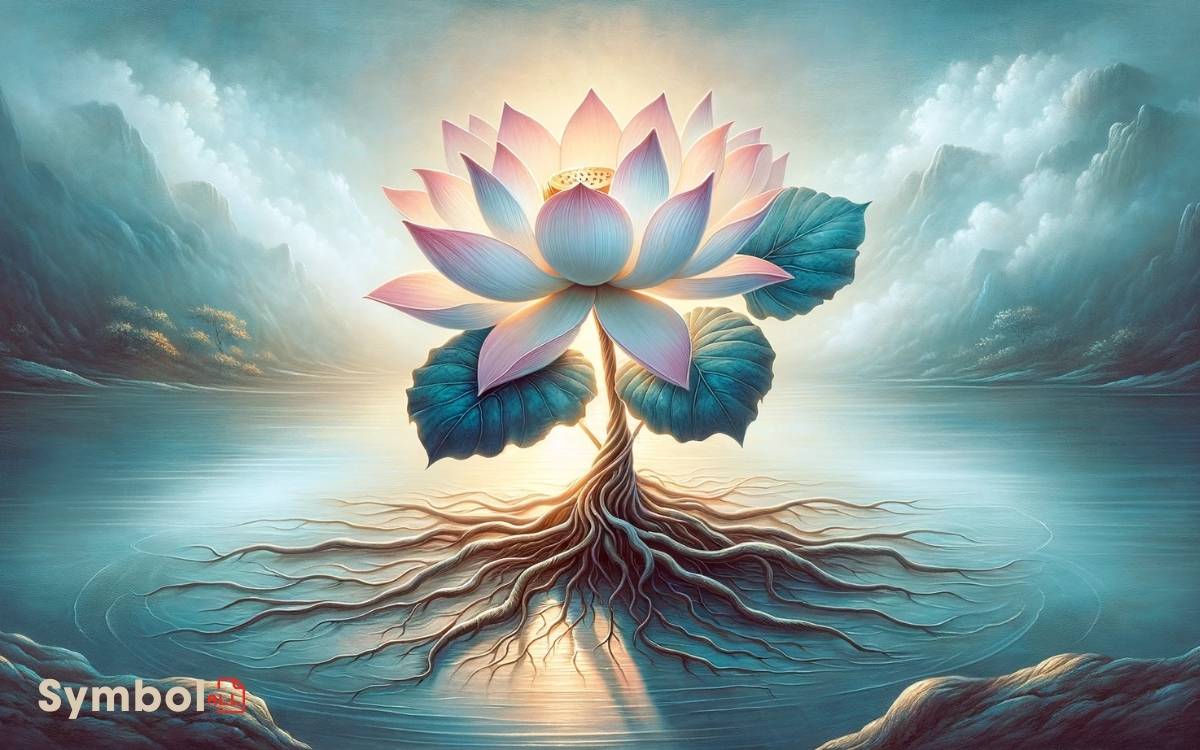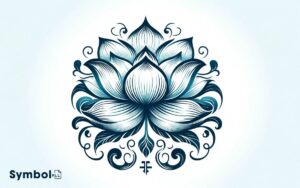Symbol of Lotus Flower in Buddhism: Purity, Enlightenment!
In Buddhism, you’ll find the lotus flower symbolizing purity and enlightenment, showing you an elegant metaphor for the spirit’s ability to rise above the mud of the material world.
This concept mirrors the Buddhist path to enlightenment, illustrating how one can achieve purity of mind and spirit despite life’s challenges.
The lotus’s journey from muddy waters to blooming flower signifies rebirth and spiritual awakening, highlighting the potential within all beings for such transformation.
Its presence in art and scriptures underscores these themes, offering deeper insights into Buddhist teachings.
Exploring this symbol further, you uncover layers of meaning that enhance your understanding of Buddhist philosophy.

Key Takeaways
Historical Significance
Why has the lotus flower held such profound historical significance in Buddhism?
Its roots in the religion stretch back to the very early texts, where the lotus is frequently mentioned and revered.
This flower’s historical significance is deeply intertwined with the narrative of Buddhism itself. It’s not merely a symbol; it represents the core teachings and the historical journey of Buddhism from its inception.
The lotus is found in countless art forms, scriptures, and architectural designs associated with Buddhism, serving as a constant reminder of the religion’s heritage and teachings.
Its presence in early Buddhist artworks symbolizes the integration of Buddhist principles into the daily lives of its followers, illustrating how deeply the symbolism of the lotus is woven into the fabric of Buddhist history and practice.
Purity and Enlightenment
Building on its historical roots in Buddhism, the lotus flower also embodies the ideals of purity and enlightenment central to the religion’s teachings.
You might wonder how a single symbol can represent such profound concepts. The answer lies in the lotus’s unique characteristic of blooming in muddy waters, yet remaining unstained.
This mirrors the Buddhist journey towards enlightenment, rising above the murky waters of material existence and ignorance.
| Aspect | Lotus Symbolism | Buddhist Teaching |
|---|---|---|
| Water | Murky, unclear | Material world |
| Bloom | Pure, untouched | Spiritual purity |
| Growth | Through mud | Overcoming ignorance |
| Light | Seeking surface | Enlightenment path |
| Root | Deep in mud | Innate Buddha nature |
This table underscores the parallel between the lotus’s life cycle and the Buddhist path to enlightenment, highlighting the inherent purity and potential for enlightenment within all beings.
Rebirth and Transformation
In Buddhism, the lotus flower’s journey from murky waters to blooming above the surface embodies the process of rebirth and transformation.
You’ll find that its symbolic meanings are deeply intertwined with practices of meditation, serving as a potent reminder of the potential for enlightenment within all beings.
This exploration reveals how the lotus not only signifies spiritual awakening but also guides individuals in their quest for purity and transcendence.
Symbolic Meanings Explored
Throughout history, the lotus flower has served as a powerful symbol of rebirth and transformation in Buddhist philosophy, encapsulating the profound journey from ignorance to enlightenment.
| Aspect | Symbolism |
|---|---|
| Blooming Process | Enlightenment journey from ignorance to wisdom |
| Mud Origin | Remaining unaffected by worldly temptations |
| Color Variation | Different stages of spiritual awakening |
| Unfolding Petals | Expansion of the soul, reaching potential |
| Pure Beauty | Innate purity of the human spirit |
This symbolism is not merely aesthetic but carries deep doctrinal significance, guiding adherents on their path to enlightenment.
The lotus represents the potential for personal transformation amidst the challenges of human existence, emphasizing the possibility of purity and enlightenment regardless of one’s circumstances.
Lotus in Meditation Practices
The incorporation of the lotus symbol into meditation practices reflects its significance in Buddhist rebirth and transformation narratives.
Through meditation, you’re invited to embody the lotus’s journey, emerging pure from murky waters, symbolizing enlightenment arising from the shadowy domains of ignorance.
This practice isn’t merely symbolic but serves as a profound method for internalizing the principles of purity, enlightenment, and spiritual awakening.
As you meditate, visualizing the lotus, you engage in a transformative process, mirroring the flower’s ascent from darkness to light.
This visualization not only aids in focusing the mind but also inculcates a deeper understanding of Buddhist teachings on rebirth and transformation, fostering a personal journey towards enlightenment and purity.
Lotus in Buddhist Art
One frequently encounters the lotus symbol within Buddhist art, embodying purity and enlightenment amid worldly suffering.
This motif serves as a visual metaphor, representing the potential for spiritual growth despite adverse conditions.
In murals, sculptures, and paintings, the lotus is often depicted beneath the seated figures of Buddhas and Bodhisattvas, signifying their divine origin and purity of mind.
The variety in color and form of the lotus within these artworks further conveys specific teachings and attributes.
For instance, a white lotus typically symbolizes mental purity and spiritual perfection, whereas a pink lotus is associated with the historical Buddha.
Through careful analysis, you’ll discern how these artistic representations communicate complex philosophical concepts, enhancing your understanding of Buddhist principles and the significant role art plays in its expression.
The Lotus Sutra Explained
Focusing on the Lotus Sutra, you encounter one of Buddhism’s most profound texts, which encapsulates core teachings and rich symbolism.
Understanding the sutra’s emphasis on the potential for enlightenment inherent in all beings is crucial, a concept symbolized by the lotus flower’s purity emerging from muddy waters.
Exploring its narratives and parables uncovers profound insights into the nature of reality and the path to spiritual awakening.
Core Teachings Summarized
At the heart of Buddhist teachings, the Lotus Sutra encapsulates the profound principle that everyone possesses the potential for enlightenment. This text is a cornerstone, offering insight into the path to awakening.
Here’s a summary of its core teachings:
- Skillful Means (Upaya): It illustrates how the Buddha adapts his teachings to suit the capacity of different beings.
- One Vehicle (Ekayana): Proposes that there’s only one path to enlightenment, contrary to the idea of multiple paths for people of varying capabilities.
- Buddha Nature: Asserts that all beings inherently possess the Buddha nature, a potential for enlightenment.
- Eternal Buddha: Suggests that the Buddha’s existence is timeless, and his teachings are eternal, guiding sentient beings through countless generations.
Symbolism in Lotus Sutra
Building upon the core teachings summarized earlier, the Lotus Sutra employs potent symbolism to illustrate the path to enlightenment, with the lotus flower serving as a central metaphor.
| Symbol | Significance |
|---|---|
| Lotus Flower | Purity amid adversity; potential for enlightenment |
| Mud | The suffering and impurities of the worldly life |
| Water | The nourishment of wisdom and teachings |
| Sunlight | The illumination of knowledge and insight |
This table encapsulates the essence of the Lotus Sutra’s message. The lotus, emerging pristine from murky waters, symbolizes the individual’s capacity to rise above worldly suffering through enlightenment.
This imagery underscores the sutra’s assertion that enlightenment is accessible to all, regardless of one’s current state of spiritual impurity.
Modern Interpretations
Exploring modern interpretations, you’ll find that the symbolism of the lotus flower in Buddhism has evolved, reflecting current societal values and spiritual understandings.
This evolution resonates through various dimensions:
- Personal Growth: The lotus symbolizes the individual’s journey toward enlightenment, emphasizing personal development and self-awareness.
- Social Harmony: It represents the ideal of living harmoniously within a community, promoting peace and understanding.
- Environmental Consciousness: The flower’s growth from muddy waters to bloom above the surface is increasingly seen as a metaphor for ecological balance and sustainability.
- Inclusivity: Modern interpretations often stress the inclusivity inherent in the lotus symbol, highlighting the Buddhist principle of compassion and acceptance for all beings.
These contemporary readings underscore the lotus flower’s enduring relevance, bridging ancient wisdom with modern challenges and aspirations.
What is the significance of the lotus flower in Buddhism and the Om symbol?
The lotus flower holds great importance in Buddhism as a symbol of purity and enlightenment. Its ability to rise from the muddy water and bloom into a beautiful flower represents spiritual growth. Similarly, the “meaning of om symbol” in Hinduism and Buddhism signifies the essence of the ultimate reality and the interconnectedness of all things.
Conclusion
The lotus flower isn’t just a plant in Buddhism; it’s the cosmos crammed into petals, encapsulating purity, enlightenment, rebirth, and transformation. Its roots in muddy water, yet blossoming above the murk, symbolize an epic journey from ignorance to wisdom.
The Lotus Sutra isn’t just a text; it’s the blueprint of the universe, offering profound insights.
As for modern interpretations, they don’t merely adapt; they catapult the lotus’s symbolism into the stratosphere, ensuring its timeless relevance in guiding souls towards enlightenment.






